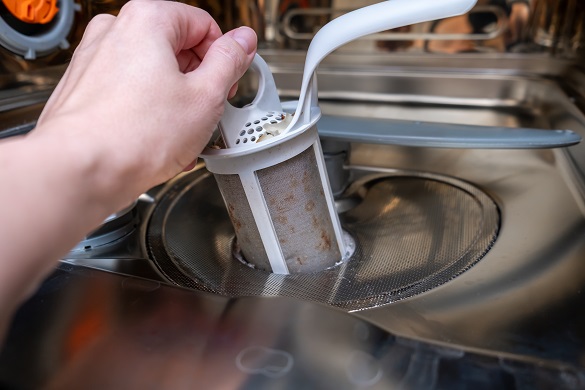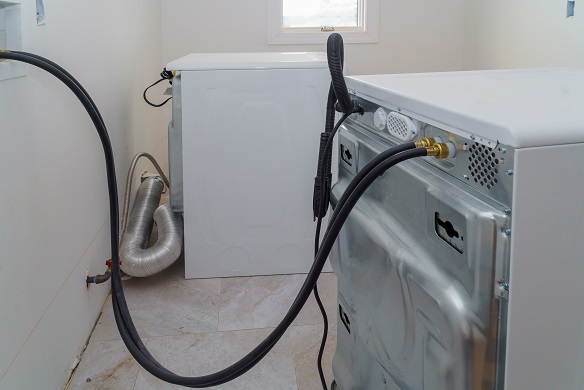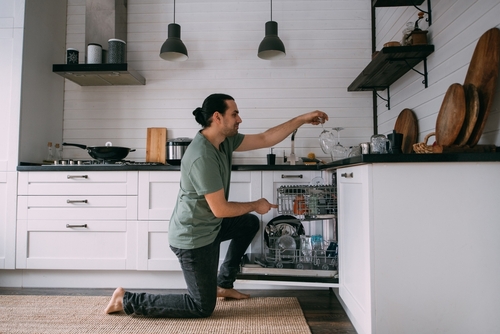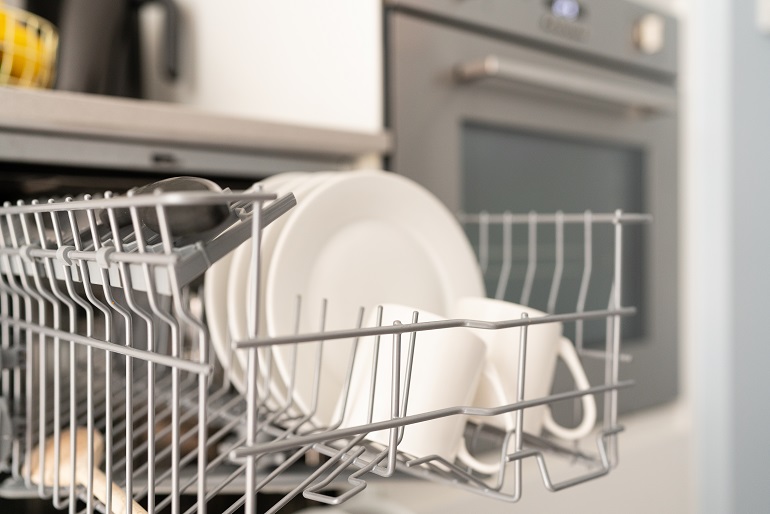When your dishwasher isn’t draining properly, you’re left with a load of dirty water after each wash. That water is unhygienic, hard to remove and may indicate a mechanical fault with your dishwasher.
However, you needn’t rush to book a dishwasher repair. There are some simple home solutions that you can try first, to fix your dishwasher not draining.
First though, be aware that some dishwashers always leave a little water in the bottom after a cycle. You can check the appliance manual to see if this is normal, or contact the manufacturer about it.
Reasons why your dishwasher might not be draining
A blocked filter is the most common reason for a dishwasher not draining. We recommend checking the filter first, because that’s quite easy to solve yourself. If the filter isn’t blocked, the other potential reasons are:
- A blockage in the dishwasher’s drain hose
- Debris in the dishwasher’s drain pump
- Using the wrong cleaning product in the dishwasher (washing up liquid, for example)
- A mechanical or electrical fault in the dishwasher
The first three of these are easy enough to solve without professional help, if you feel comfortable. Once you’ve eliminated those reasons, it’s time to call a qualified engineer to fix your dishwasher.
How to unblock your dishwasher
To unblock your dishwasher, you don’t need any special skills or equipment. All you might need is:
- The dishwasher’s manual
- Washing up gloves
- A bucket
- A cup
- Some towels
- A brush with soft bristles (an old toothbrush will do)
- A screwdriver
Before trying to fix anything, there are a couple of things you must do:
- Unplug the dishwasher from the power
- Make sure the dishwasher is empty
- Take any standing water out of the dishwasher
Once you’ve done these, you’re ready to start. We’ll cover the things to check in order.
1. Remove and unclog the filter

Your dishwasher’s filter is typically found in the centre of the appliance’s floor, under the bottom rack. The filter might be attached to a metal grille or plate with holes in it. Most of the time you can pull the grille off by hand, but some need a screwdriver.
The filter itself is often a plastic cylinder that you can pull or twist out. If you need to twist, there should be arrows showing the direction to turn it.
A clogged filter will have visible bits or debris in the fine mesh inside. Run it under the tap to dislodge the blockage, and scrub it with a sponge or an old toothbrush.
While the filter is out of the machine, check the pit under where the filter was located. If anything has managed to fall in there, you can pull it out. Be sure to wear protective gloves for this.
2. Unblock the filter pump
Something solid, like broken glass, may have fallen into the dishwasher’s drain or filter pump. This will stop the appliance draining effectively and may cause an unusual noise when the pump is struggling.
How you unblock the pump will depend on the make and model of your dishwasher. Always check the manual that came with the appliance for any specific guidance. The manufacturer may also have some instructional videos you can follow.
Remember to use gloves when you’re reaching into the pump area, as sharp objects could cut your hands.
3. Check the drain hose

A drain hose can cause problems if it wasn’t installed properly or has built up residue over time.
A few things that can go wrong with a dishwasher’s drain hose are:
- Not being connected properly at either end
- Being squashed or kinked, restricting the flow
- Getting blocked with food or other debris
Any one of these can stop water from flowing out, causing a backup of water in your dishwasher.
The dishwasher’s manual should tell you how to disconnect the drain hose. Put down enough towels before trying to disconnect it, or you may have a small flood on your hands.
Other reasons for a dishwasher not draining
If you’ve exhausted the common reasons for a dishwasher not draining, you might have a mechanical fault or plumbing issue.
Faulty parts that can stop a dishwasher draining include:
- Drain hose check valve
- Drain pump piston and nut assembly
- Drain motor
- Drain solenoid valve
- Electronic control board
You’ll need a professional engineer to fix your dishwasher or replace these parts safely.
On the other hand, the problem may be with your plumbing rather than the dishwasher. It’s worth checking whether your sink drain is blocked — if so, this may be stopping the dishwasher from draining properly. You can try using a drain unblocker product or a drain snake to clear it.
Tips to keep your dishwasher working properly

While some dishwasher faults are unavoidable, there are small things you can do every day to help keep yours running:
- Scrape crumbs and food scraps from the dishes before loading the dishwasher.
- Use a hot water cycle on the dishwasher, at least some of the time.
- Wipe the dishwasher on the inside and outside, wherever you can reach.
- Check and clean the dishwasher filter at least once a week.
- Always use appropriate detergent in the dishwasher, not washing up liquid or something else.
Our blog is loaded with more related articles

Dishwasher tips
How much does it cost to run a dishwasher?
Let’s be honest. Nobody likes washing up. For those of us who like to cut down on time spent at the kitchen sink, dishwas...
Read more

Dishwasher tips
How to use your dishwasher and save energy
In this guide, we’ll give you the tips you need to save energy and money while making your dishes sparkle. The good news...
Read more

Dishwasher tips
Common dishwasher problems and how to fix them
Although your dishwasher can take all the strain away from washing up, and helps hygienically clean your dishes, it still needs...
Read more
